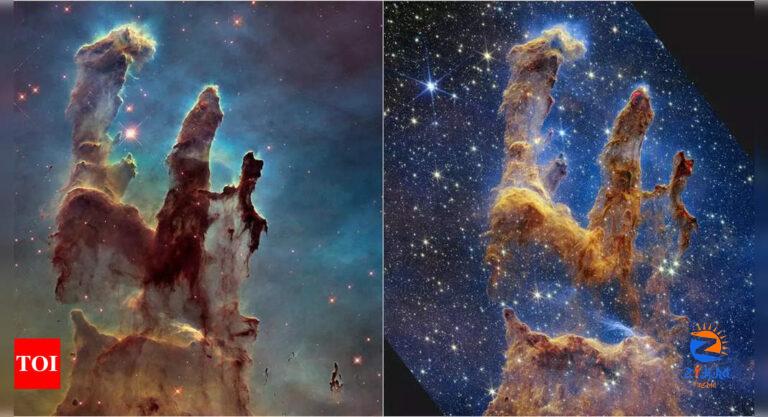
[ad_1]
Now, NASA has unveiled a new 3D visualization of these celestial giants, crafted using data from both the Hubble and James Webb Space Telescopes.This latest visualization represents the most detailed multiwavelength movie of the Pillars of Creation to date.
The four Pillars, composed mainly of cool molecular hydrogen and dust, are being shaped and eroded by the intense winds and ultraviolet light emitted by nearby young, hot stars. The towering structures, some of which stretch across three light-years, are home to finger-like extensions that contain developing stars. For perspective, the tallest pillar reaches three-quarters of the distance between our Sun and the closest star.
Video of Pillars of Creation visualization
Pillars of Creation Star in New Visualization from NASA’s Hubble and Webb Telescopes
What are the Pillars of Creation?
The Pillars of Creation are colossal structures located in the heart of the Eagle Nebula, famously captured by NASA’s Hubble Space Telescope in 1995. These towering formations are primarily composed of cool molecular hydrogen and dust, and they are known for their striking, ethereal beauty. The pillars feature finger-like extensions that house developing stars and stretch across vast distances, with the tallest pillar extending three light-years.
Why are Pillars of Creation so special?
The Pillars of Creation are significant because they provide a dramatic visual representation of star formation. The intense winds and ultraviolet light from nearby young stars are actively eroding the pillars, creating a dynamic environment where new stars are born. This region of space acts as a cosmic nursery, offering valuable insights into the processes that govern star formation and the evolution of stellar structures.
The new 3D movie immerses viewers in the intricate, three-dimensional structures of the pillars. Unlike artistic renditions, this video is grounded in observational data from a study led by Anna McLeod, an associate professor at the University of Durham. McLeod also contributed as a scientific advisor to the project. The visualization demonstrates how the combined capabilities of the Hubble and Webb telescopes offer a richer, more detailed view of the pillars. Hubble captures objects glowing in visible light, while Webb’s infrared vision allows it to peer through the dust and reveal cooler, embedded stars.
According to NASA reports, Mark Clampin, Astrophysics Division director at NASA Headquarters in Washington notes “When we combine observations from NASA’s space telescopes across different wavelengths of light, we broaden our understanding of the universe.” He further added, “The Pillars of Creation region continues to offer us new insights that hone our understanding of how stars form. Now, with this new visualization, everyone can experience this rich, captivating landscape in a new way.”
Produced for NASA by the Space Telescope Science Institute (STScI) in collaboration with Caltech/IPAC and developed by NASA’s AstroViz Project, this 3D visualization is part of a broader narrated video. It aims to engage audiences of all ages, including youth, families, and lifelong learners, by connecting them with the science and scientists behind NASA’s Astrophysics missions. This educational tool helps viewers explore fundamental scientific questions, gain insight into the scientific process, and discover the wonders of the universe.
Can the Pillars of Creation be seen from Earth?
While the Pillars of Creation cannot be directly observed with the naked eye from Earth, they can be seen through powerful telescopes. According to NASA, they would be more clearly visible in July in clear weather conditions.
Also read: |Ladakh discovery unveils key clues for extraterrestrial life
[ad_2]
